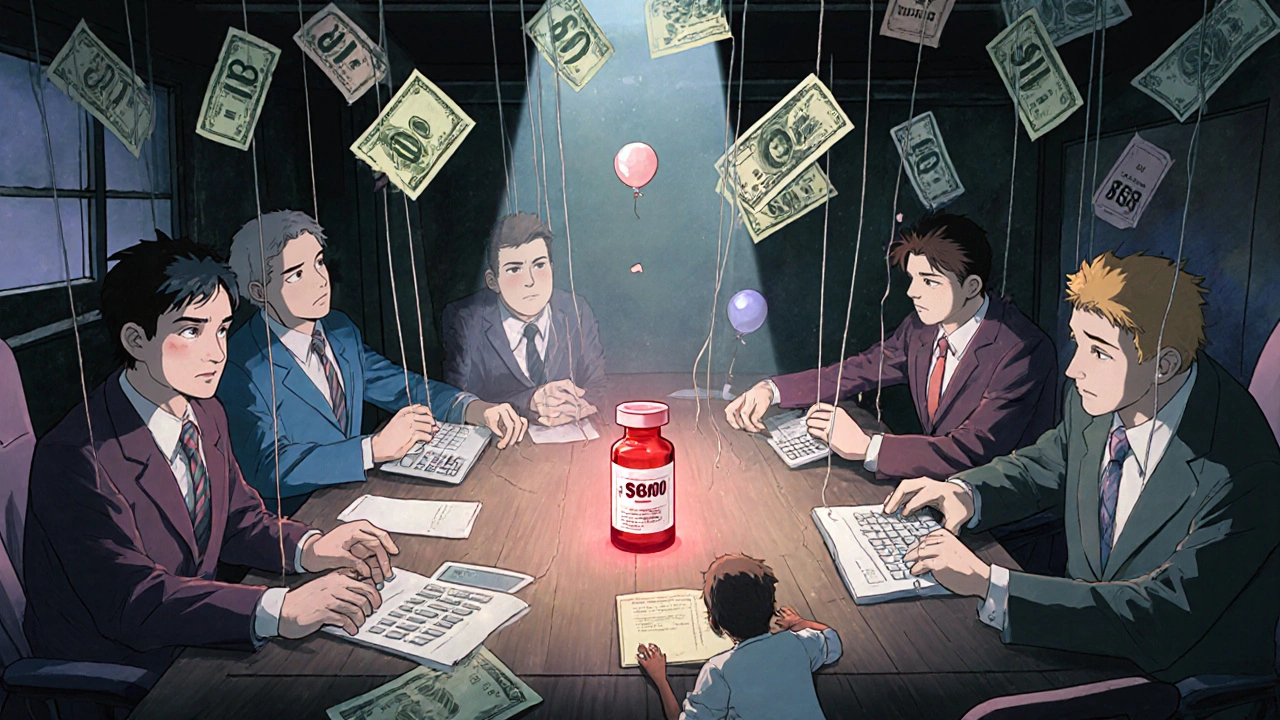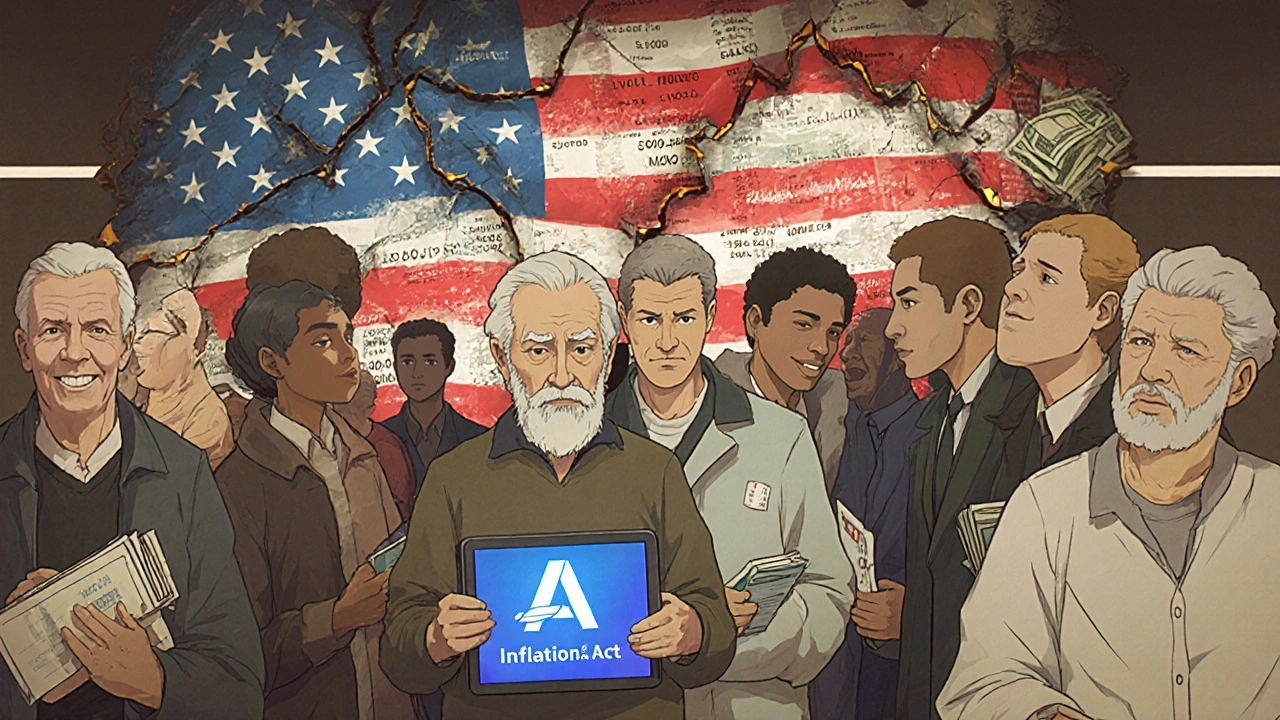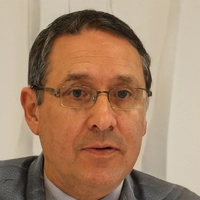If you’ve ever stared at a pharmacy receipt and wondered how a small bottle of pills could cost more than your monthly internet bill, you’re not alone. Americans pay three times more for the exact same prescription drugs than people in Canada, Germany, or the UK. And it’s not because U.S. drugs are better. They come from the same factories. Same ingredients. Same science. So why the gap?
The System Was Built to Let Companies Set Any Price
The U.S. is the only developed country where drugmakers can charge whatever they want - no caps, no negotiations, no rules. In most other nations, the government steps in and says, “This is what we’ll pay.” In the U.S., the law actually forbids it. The Medicare Modernization Act of 2003 made it illegal for Medicare, which covers over 65 million people, to negotiate drug prices directly with manufacturers. That single decision turned Medicare into the biggest buyer in the world that can’t haggle. Imagine going to a car dealership and being told, “You can’t ask for a discount.” That’s Medicare’s reality.Meanwhile, private insurers and Pharmacy Benefit Managers (PBMs) - middlemen hired to manage drug benefits - have become powerful players. Originally meant to cut costs, many PBMs now make money by pushing drugs with higher list prices. Why? Because their fees are based on a percentage of those prices. The higher the sticker price, the bigger their cut. So if a drug costs $1,000 instead of $300, the PBM gets more. The patient? They still pay the same out-of-pocket amount, unless they’re on Medicare or have good insurance. And even then, they’re often stuck with the inflated price.
Specialty Drugs Are Breaking the Bank
Not all drugs are created equal. Some, like those for diabetes, obesity, cancer, or rare diseases, are called “specialty drugs.” These aren’t your average pills. They’re complex, expensive to make, and often require special handling. But here’s the kicker: they’re also the main reason drug spending is skyrocketing. In 2024, net drug prices in the U.S. jumped 11.4% - up from 4.9% the year before. And nearly all of that growth came from just a handful of drugs.Take Ozempic and Wegovy - drugs used for weight loss and diabetes. In 2025, after public pressure and a White House announcement, their prices dropped from $1,000 and $1,350 a month to $350. That’s a win. But before that? Those prices were set by the manufacturer with zero oversight. And even now, the $350 price is still more than double what people pay in other countries for the same medicine.
Then there’s Galzin, a treatment for Wilson’s disease. In the U.S., it costs $88,800 a year. In the UK? $1,400. In Germany? $2,800. That’s not inflation. That’s not R&D. That’s a 1,555% markup. And this isn’t rare. A Senate report found 688 drugs increased in price since 2017 - even as the White House promised to lower costs. The system isn’t broken. It’s working exactly as designed: to maximize profits.
The Inflation Reduction Act Tried to Fix It - But It’s Not Enough
In 2022, Congress passed the Inflation Reduction Act. It was the biggest change to drug pricing in decades. For the first time, Medicare could negotiate prices for a small number of high-cost drugs. In 2026, ten drugs will be covered under this program. That’s it. Ten. Out of thousands. And even that progress is under threat. A 2025 budget bill weakened the law, potentially adding $5 billion in extra costs to Medicare.But there’s another part of the law that’s actually working: inflation rebates. If a drug’s price goes up faster than inflation, the manufacturer has to pay Medicare back. In early 2025, this rule saved money on 64 drugs. For seniors, that meant lower Part B coinsurance rates. It’s a start. But it only applies to drugs already covered by Medicare. It doesn’t touch private insurance. And it doesn’t help the 30 million Americans without any prescription coverage.

Why Other Countries Don’t Have This Problem
Countries like Canada, Germany, and the UK don’t rely on market forces to set drug prices. They use what’s called “reference pricing.” If a drug costs $500 in France, they won’t pay more than that - even if the U.S. price is $2,000. They also negotiate as a group. One buyer. One price. That gives them leverage. The U.S. has over 1,000 different insurers and PBMs, each negotiating separately. That’s chaos. And it benefits the drugmakers, not the patients.Even more telling: the U.S. accounts for less than 5% of the world’s population - but generates 75% of global pharmaceutical profits. That’s not because Americans are sicker. It’s because they’re paying more. And that extra money doesn’t just go to research. A lot of it goes straight to shareholder dividends and executive pay. In 2024, the top five drug companies spent more on stock buybacks than on R&D.
Real People Are Choosing Between Food and Medicine
Behind every price tag is a real person. A senior on fixed income. A parent with a child on insulin. Someone with cancer who needs a $10,000-a-month drug. The Medicare Rights Center found that millions of Americans skip doses, cut pills in half, or go without because they can’t afford their prescriptions. The Inflation Reduction Act’s $2,000 annual cap on out-of-pocket drug costs for Medicare beneficiaries will help - but only for those enrolled in Medicare Part D. What about the 28 million Americans who don’t have drug coverage at all? Or the ones who get insurance through work but still face $500 monthly copays?And now, there’s Project 2025 - a policy proposal that could roll back current protections. The Center for American Progress warns it could raise costs for 18.5 million seniors and people with disabilities. That means more people choosing between insulin and rent. Between asthma inhalers and groceries. Between life and affordability.

The Real Culprits: Lobbying, Patents, and Lack of Transparency
Drug companies spend hundreds of millions every year lobbying Congress. In 2024 alone, they spent over $300 million trying to block price controls. They also use patent tricks - filing dozens of minor patents on the same drug to extend exclusivity. That’s called “evergreening.” It keeps generics off the market for years longer than needed.And there’s almost no transparency. You can’t walk into a pharmacy and see what the drug actually cost the manufacturer. You don’t know how much the PBM took. Or how much the insurer paid. The HHS is finally pushing for real-time price transparency, but it’s still years away from being enforced. Meanwhile, patients are left guessing why their $20 pill suddenly costs $120.
What’s Next? The Fight Isn’t Over
There’s no single fix. But the path forward is clear: allow Medicare to negotiate prices for all drugs, not just ten. Ban rebate structures that reward higher prices. Limit patent abuse. Force drugmakers to justify price hikes. And make pricing transparent so patients can shop around.Some lawmakers are pushing bills like the Prescription Drug Price Relief Act, which would tie U.S. prices to those in other major countries. It’s simple. It’s fair. And it’s backed by data. But it’s also opposed by the same companies that profit from the current system.
For now, the system remains broken. And the people paying the price aren’t CEOs or shareholders. They’re the ones standing in line at the pharmacy, hoping their card doesn’t get declined.
Why are prescription drugs more expensive in the U.S. than in other countries?
The U.S. is the only developed country that doesn’t allow the government to negotiate drug prices. Other nations set price caps or use reference pricing based on what other countries pay. In the U.S., drugmakers set prices freely, and middlemen like Pharmacy Benefit Managers (PBMs) often profit from higher list prices, not lower ones.
Does the Inflation Reduction Act lower drug prices for everyone?
No. It only affects Medicare Part D beneficiaries and only applies to a small number of high-cost drugs. The law lets Medicare negotiate prices for ten drugs starting in 2026, and it requires drugmakers to pay rebates if prices rise faster than inflation. But it doesn’t help people on private insurance or those without drug coverage.
What role do Pharmacy Benefit Managers (PBMs) play in high drug prices?
PBMs were created to negotiate discounts, but many now make money by pushing drugs with higher list prices. Their fees are often based on a percentage of the drug’s list price, so they benefit when prices go up - even if the patient pays the same copay. This creates a conflict of interest that keeps prices inflated.
Why do some drugs cost tens of thousands of dollars a year?
These are called specialty drugs - often for rare or chronic conditions like cancer, diabetes, or autoimmune diseases. While they’re expensive to develop, manufacturers charge far more than the cost of production. For example, Galzin, a treatment for Wilson’s disease, costs $88,800 in the U.S. but only $1,400 in the UK. The difference isn’t in manufacturing - it’s in pricing power.
Can I buy cheaper drugs from other countries?
Technically, yes - many people buy from Canada or other countries where prices are lower. But U.S. law technically bans importing prescription drugs from abroad. Enforcement is inconsistent, and safety risks exist if you buy from unverified online pharmacies. Some states are exploring official import programs, but they’re still limited.
Are drug companies really spending more on R&D than on profits?
No. In 2024, the top five U.S. drug companies spent more money buying back their own stock to boost share prices than they did on research and development. While R&D is expensive, most profits go to dividends, executive pay, and shareholder returns - not innovation.
What You Can Do Right Now
If you’re struggling with drug costs, here’s what actually works:- Ask your doctor for a generic version - it’s often 80% cheaper.
- Use GoodRx or SingleCare to compare prices at nearby pharmacies - prices vary wildly.
- Apply for patient assistance programs through drugmakers - many offer free or low-cost meds to low-income patients.
- If you’re on Medicare, check if your drug is part of the new negotiation program - your copay may drop in 2026.
- Call your insurer and ask why your drug cost so much - sometimes they can override a prior authorization denial.
There’s no magic fix. But understanding how the system works is the first step to fighting back.



10 Comments
Florian Moser
November 21, 2025 AT 13:55It’s wild how the system is literally designed to exploit people. I had to choose between my insulin and my rent last year. I’m not even on Medicare yet. This isn’t healthcare-it’s a casino where the house always wins. And yet, we keep acting like it’s normal.
jim cerqua
November 23, 2025 AT 07:57LET ME TELL YOU SOMETHING-THIS ISN’T JUST BROKEN, IT’S A CRIME SYNDICATE IN LAB COATS. $88,000 FOR A DRUG THAT COSTS $1,400 IN THE UK?! THAT’S NOT CAPITALISM-THAT’S ROBBERY WITH A PHARMACEUTICAL STAMP ON IT. THEY’RE NOT INVENTING CURES, THEY’RE INVENTING EXCUSES TO CHARGE MORE. AND DON’T EVEN GET ME STARTED ON PBMs-they’re the middlemen who get rich while you get bankrupt. THIS SYSTEM IS A SCAM, AND WE’RE ALL THE VICTIMS.
Sammy Williams
November 23, 2025 AT 12:26Yeah, I’ve used GoodRx before and saved like 70% on my meds. Honestly, most people don’t even know it exists. Also, a lot of drug companies have patient programs-if you’re struggling, just call them. They’ll help. It’s not perfect, but it’s something.
David vaughan
November 25, 2025 AT 08:04Wow. Just... wow. I mean, I knew it was bad, but I didn’t realize it was THIS bad. Like, $10,000 a month for cancer meds?! And PBMs profit off that?! I feel sick. I’ve been on insulin for 12 years. I’ve cut pills in half. I’ve skipped doses. I didn’t think anyone else knew how bad it got. Thank you for saying this out loud.
Cooper Long
November 25, 2025 AT 12:18The structural failure of the U.S. pharmaceutical pricing model is a direct consequence of deregulatory ideology prioritizing market autonomy over public welfare. Comparative reference pricing, as employed by OECD nations, demonstrates that centralized negotiation yields equitable outcomes without compromising innovation. The U.S. exception is not a virtue-it is a policy failure.
Sheldon Bazinga
November 26, 2025 AT 00:31LMAO so now we're gonna copy canada? lol what a joke. they don't even have enough drugs in stock. if you want meds that work, you need the free market. these drug companies invented life saving stuff. you think some bureaucrat in germany knows better than the scientists? dumbass. also, get a job and afford it. stop crying.
Sandi Moon
November 27, 2025 AT 14:46Let’s not pretend this is about profits. This is a deliberate, coordinated effort by the Deep State and Big Pharma to control the population. The same entities that pushed lockdowns are now ensuring you’re chemically dependent on overpriced medications. The 2022 Inflation Reduction Act? A distraction. A placebo. They want you distracted while they consolidate power. Watch what happens when Medicare negotiation expands-suddenly, shortages will appear. Always happens.
Kartik Singhal
November 28, 2025 AT 11:50USA = capitalism = success. Why do you think every other country wants to be like us? We have the best tech, the best drugs, the best innovation. You want cheap pills? Go live in India. They have generics for $1. But you want quality? Then pay for it. Also, why are you even on Reddit? Go get a real job.
Clifford Temple
November 28, 2025 AT 22:03You people are pathetic. You think the government should fix this? That’s what got us here. The only reason drug prices are high is because you’re too lazy to work harder. If you can’t afford your meds, don’t take them. Or better yet-don’t get sick. Stop blaming corporations for your bad life choices.
Corra Hathaway
November 29, 2025 AT 10:20Okay but can we talk about how the same people who scream 'free market!' are now crying because they got scammed by the free market? 😂 Also, I just got my Ozempic for $350 and I’m still mad it’s not $50. Also, I used GoodRx and saved $180 on my antidepressants. The system is rigged, but we’re fighting back. 💪 #PharmacyStrike